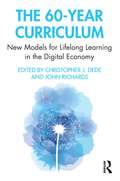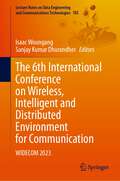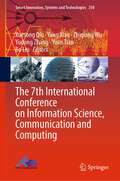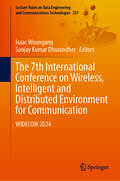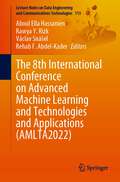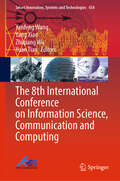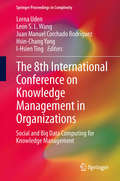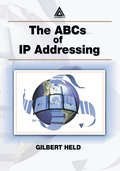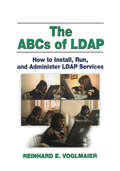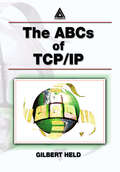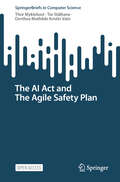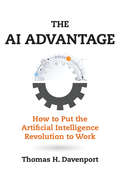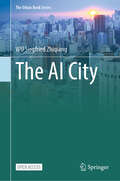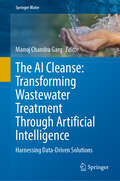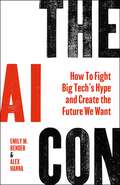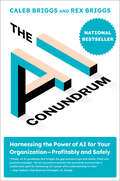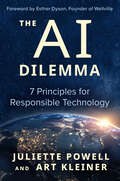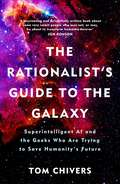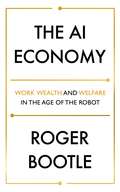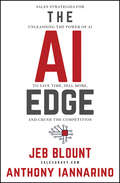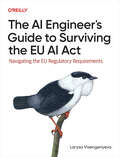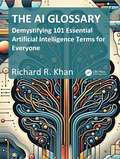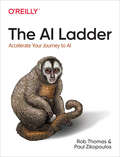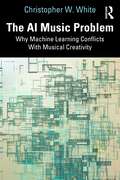- Table View
- List View
The 60-Year Curriculum: New Models for Lifelong Learning in the Digital Economy
by Christopher J. DedeThe 60-Year Curriculum explores models and strategies for lifelong learning in an era of profound economic disruption and reinvention. Over the next half-century, globalization, regional threats to sustainability, climate change, and technologies such as artificial intelligence and data mining will transform our education and workforce sectors. In turn, higher education must shift to offer every student life-wide opportunities for the continuous upskilling they will need to achieve decades of worthwhile employability. This cutting-edge book describes the evolution of new models—covering computer science, inclusive design, critical thinking, civics, and more—by which universities can increase learners’ trajectories across multiple careers from mid-adolescence to retirement. Stakeholders in workforce development, curriculum and instructional design, lifelong learning, and higher and continuing education will find a unique synthesis offering valuable insights and actionable next steps.
The 6th International Conference on Wireless, Intelligent and Distributed Environment for Communication: WIDECOM 2023 (Lecture Notes on Data Engineering and Communications Technologies #185)
by Isaac Woungang Sanjay Kumar DhurandherThis book presents the proceedings of the 6th International Conference on Wireless Intelligent and Distributed Environment for Communication (WIDECOM 2023), which took place at Brock University, St. Catharines, Ontario, Canada, October 11-13, 2023. The book addresses issues related to new dependability paradigms, design, and performance of dependable network computing and mobile systems, as well as issues related to the security of these systems. The goal of the conference is to provide a forum for researchers, students, scientists and engineers working in academia and industry to share their experiences, new ideas and research results in the above-mentioned areas.
The 7 Qualities of Highly Secure Software
by Mano PaulThe 7 Qualities of Highly Secure Software provides a framework for designing, developing, and deploying hacker-resilient software. It uses engaging anecdotes and analogies-ranging from Aesop's fables, athletics, architecture, biology, nursery rhymes, and video games-to illustrate the qualities that are essential for the development of highly secure
The 7th International Conference on Information Science, Communication and Computing (Smart Innovation, Systems and Technologies #350)
by Bo Liu Xuesong Qiu Yang Xiao Zhiqiang Wu Yuan Tian Yudong ZhangThis conference proceedings is a collection of the accepted papers of ISCC2023 - the 7th International Conference on Information Science, Communication and Computing held in Chongqing, China, 2-5 June 2023. The topics focus on intelligent information science and technology, artificial intelligence and intelligent systems, cloud computing and big data, smart computing and communication technology, wireless network, and cyber security. Each part can be used as an excellent reference by industry practitioners, university faculties, research fellows, and undergraduate and graduate students who need to build a knowledge base of the latest advances and state of the practice in the topics covered by this conference proceedings. This will enable them to build, maintain and manage systems of high reliability and complexity. We would like to thank the authors for their hard work and dedication, and the reviewers for ensuring that only the highest quality papers were selected.
The 7th International Conference on Wireless, Intelligent and Distributed Environment for Communication: WIDECOM 2024 (Lecture Notes on Data Engineering and Communications Technologies #237)
by Isaac Woungang Sanjay Kumar DhurandherThis book presents the proceedings of the 7th International Conference on Wireless Intelligent and Distributed Environment for Communication (WIDECOM 2024), which took place at Keene State College, Keene, New Hampshire, USA, October 16-18, 2024. The book addresses issues related to new dependability paradigms, design, and performance of dependable network computing and mobile systems, as well as issues related to the security of these systems. The goal of the conference is to provide a forum for researchers, students, scientists and engineers working in academia and industry to share their experiences, new ideas and research results in the above-mentioned areas.
The 8th International Conference on Advanced Machine Learning and Technologies and Applications (Lecture Notes on Data Engineering and Communications Technologies #113)
by Václav Snášel Aboul Ella Hassanien Rawya Y. Rizk Rehab F. Abdel-KaderThis book constitutes the refereed proceedings of the 8th International Conference on Advanced Machine Learning Technologies and Applications, AMLTA 2022, held in Cairo, Egypt, during May 5-7, 2022. The 8th edition of AMLTA will be organized by the Scientific Research Group in Egypt (SRGE), Egypt, collaborating with Port Said University, Egypt, and VSB-Technical University of Ostrava, Czech Republic. AMLTA series aims to become the premier international conference for an in-depth discussion on the most up-to-date and innovative ideas, research projects, and practices in the field of machine learning technologies and their applications. The book covers current research on advanced machine learning technology, including deep learning technology, sentiment analysis, cyber-physical system, IoT, and smart cities informatics and AI against COVID-19, data mining, power and control systems, business intelligence, social media, digital transformation, and smart systems.
The 8th International Conference on Information Science, Communication and Computing (Smart Innovation, Systems and Technologies #434)
by Yang Xiao Zhiqiang Wu Yuan Tian Yanfeng WangThis conference proceedings is a collection of the accepted papers of ISCC2024 - the 8th International Conference on Information Science, Communication and Computing, held in Zhengzhou, China, 23-25 August 2024. The topics focus on intelligent information science and technology, artificial intelligence and intelligent systems, cloud computing and big data, smart computing and communication technology, wireless network and cyber security. Each part can be used as an excellent reference by industry practitioners, university faculties, research fellows and undergraduate and graduate students who need to build a knowledge base of the latest advances and state of the practice in the topics covered by these conference proceedings. This will enable them to build, maintain and manage systems of high reliability and complexity. We would like to thank the authors for their hard work and dedication, and the reviewers for ensuring that only the highest quality papers were selected.
The 8th International Conference on Knowledge Management in Organizations: Social and Big Data Computing for Knowledge Management
by Lorna Uden I-Hsien Ting Hsin-Chang Yang Leon S.L. Wang Juan Manuel Corchado RodríguezThe proceedings from the eighth KMO conference represent the findings of this international meeting which brought together researchers and developers from industry and the academic world to report on the latest scientific and technical advances on knowledge management in organizations. This conference provided an international forum for authors to present and discuss research focused on the role of knowledge management for innovative services in industries, to shed light on recent advances in social and big data computing for KM as well as to identify future directions for researching the role of knowledge management in service innovation and how cloud computing can be used to address many of the issues currently facing KM in academia and industrial sectors.
The ABCs of IP Addressing
by Gilbert HeldOur world is rapidly becoming an Internet-based world, with tens of millions of homes, millions of businesses, and within a short period of time, possibly hundreds of millions of mobile professionals accessing the literal mother of all networks. One of the key problems affecting many Internet users, ranging from individual professionals to networki
The ABCs of LDAP: How to Install, Run, and Administer LDAP Services
by Reinhard E. VoglmaierThis book explores the use of Lightweight Directory Access Protocol (LDAP) as an efficient protocol. It combines all of the relevant information available on the Internet along with a number of arguments treated in the various books that are available, and provides many examples of LDAP code.
The ABCs of TCP/IP
by Gilbert HeldAdvances in networking and communications hardware based upon the TCP/IP protocol suite are opening up a new range of technologies with the potential to contribute considerably to our daily lives. The ABCs of TCP/IP is a comprehensive reference on the TCP/IP protocol suite for professionals that provides an overview of the suite and details its key components. It addresses virtual private networks, IP telephony and voice gateways, and IPSec and examines the manner by which various protocols and applications operate. Coverage also includes security techniques, routing, network design constraints, testing methods, troubleshooting, management issues, and emerging applications.
The AI Act and The Agile Safety Plan (SpringerBriefs in Computer Science)
by Thor Myklebust Tor Stålhane Dorthea Mathilde VatnThis open access book aims to provide the reader with some basic insight into the AI Act (REGULATION (EU) 2024/1689) and its relevance for the development of high-risk AI systems. It covers all aspects relevant in a safety plan that should serve as the foundation for developing future safety cases for AI safety systems. The topics include e.g. the system definition; hardware, software and its lifecycles; stakeholders and organizations; tools, programming languages, and existing software to be integrated; documentation and work products; procurement and subcontracting; and human aspects. The book aims at experts and stakeholders involved in developing high risk systems, both manufacturers and operators. It is also written for everyone having an interest in how the AI Act impacts technology development processes generally. As such, especially start-ups and small and medium-sized enterprises (SMEs) will find this book useful.
The AI Advantage: How to Put the Artificial Intelligence Revolution to Work (Management on the Cutting Edge)
by Thomas H. DavenportCutting through the hype, a practical guide to using artificial intelligence for business benefits and competitive advantage.In The AI Advantage, Thomas Davenport offers a guide to using artificial intelligence in business. He describes what technologies are available and how companies can use them for business benefits and competitive advantage. He cuts through the hype of the AI craze—remember when it seemed plausible that IBM's Watson could cure cancer?—to explain how businesses can put artificial intelligence to work now, in the real world. His key recommendation: don't go for the “moonshot” (curing cancer, or synthesizing all investment knowledge); look for the “low-hanging fruit” to make your company more efficient.Davenport explains that the business value AI offers is solid rather than sexy or splashy. AI will improve products and processes and make decisions better informed—important but largely invisible tasks. AI technologies won't replace human workers but augment their capabilities, with smart machines to work alongside smart people. AI can automate structured and repetitive work; provide extensive analysis of data through machine learning (“analytics on steroids”), and engage with customers and employees via chatbots and intelligent agents. Companies should experiment with these technologies and develop their own expertise.Davenport describes the major AI technologies and explains how they are being used, reports on the AI work done by large commercial enterprises like Amazon and Google, and outlines strategies and steps to becoming a cognitive corporation. This book provides an invaluable guide to the real-world future of business AI.A book in the Management on the Cutting Edge series, published in cooperation with MIT Sloan Management Review.
The AI City (The Urban Book Series)
by Siegfried Zhiqiang WUThis open access book presents the concept of AI Cites for the first time. It includes the theoretical basis, development frontier, and different application scenarios of artificial intelligence cities. The book is accompanied by rich practical cases to conduct in-depth and detailed discussions on the proposition of artificial intelligence cities. It fills the gap between artificial intelligence and urban planning. This book points out the urgent human needs in the city for AI scientists to considered in the next round of AI technology development. It also provides new ideas for urban planners and researchers to solve problems with new technologies.
The AI Cleanse: Harnessing Data-Driven Solutions (Springer Water)
by Manoj Chandra GargThis groundbreaking book goes beyond conventional approaches and explores how AI is revolutionizing the field of wastewater treatment, offering innovative solutions to pressing challenges. "The AI Cleanse" takes you on a captivating journey through the convergence of AI and wastewater treatment, revealing the potential for enhanced efficiency, effectiveness, and sustainability. From optimizing treatment processes to intelligent monitoring and fault detection, this book showcases how AI-driven technologies can reshape the way we approach wastewater treatment.Gain a comprehensive understanding of the basics of wastewater treatment and the limitations of traditional methods. Explore the practical applications of AI, such as data acquisition and analysis, process optimization, and resource recovery. Learn about cutting-edge technologies, emerging trends, and future directions in the field.Written in a reader-friendly style, "The AI Cleanse" bridges the gap between theoretical knowledge and practical implementation. Packed with real-world examples, case studies, and insights from experts in the field, this book equips researchers, professionals, and students with the knowledge needed to harness the full potential of AI in wastewater treatment.If you are passionate about environmental preservation, sustainable practices, and the power of technology, "The AI Cleanse" is your guide to unlocking the transformative potential of artificial intelligence in wastewater treatment. Embrace a cleaner future and be at the forefront of this revolution in the field.
The AI Con: How to Fight Big Tech's Hype and Create the Future We Want
by Emily M. Bender Alex HannaA smart, incisive look at the technologies sold as artificial intelligence, the drawbacks and pitfalls of technology sold under this banner, and why it’s crucial to recognize the many ways in which AI hype covers for a small set of power-hungry actors at work and in the world. Is artificial intelligence going to take over the world? Have big tech scientists created an artificial lifeform that can think on its own? Is it going to put authors, artists, and others out of business? Are we about to enter an age where computers are better than humans at everything?The answer to these questions, linguist Emily M. Bender and sociologist Alex Hanna make clear, is “no,” “they wish,” “LOL,” and “definitely not.” This kind of thinking is a symptom of a phenomenon known as “AI hype.” Hype looks and smells fishy: It twists words and helps the rich get richer by justifying data theft, motivating surveillance capitalism, and devaluing human creativity in order to replace meaningful work with jobs that treat people like machines. In The AI Con, Bender and Hanna offer a sharp, witty, and wide-ranging take-down of AI hype across its many forms.Bender and Hanna show you how to spot AI hype, how to deconstruct it, and how to expose the power grabs it aims to hide. Armed with these tools, you will be prepared to push back against AI hype at work, as a consumer in the marketplace, as a skeptical newsreader, and as a citizen holding policymakers to account. Together, Bender and Hanna expose AI hype for what it is: a mask for Big Tech’s drive for profit, with little concern for who it affects.
The AI Conundrum: Harnessing the Power of AI for Your Organization--Profitably and Safely
by Caleb Briggs Rex BriggsA timely, practical guide to AI—its strengths, weaknesses, and real-world applications—for business professionals and policymakers.Artificial intelligence, or AI, can recognize a pattern from any set of data it is given, which is what makes it such an extraordinarily powerful tool. But because not all patterns are authentic or reliable, AI’s pattern-finding superpower can lead to spurious patterns—and to disastrous results for business and government entities that rely on them. Hence the conundrum at the heart of AI: its greatest strength can also be its greatest weakness. Targeting the businessperson who needs to know how to use AI profitably and responsibly, Caleb Briggs and Rex Briggs offer in this book a foundational understanding of AI that is easy to grasp yet thorough enough to be used effectively. The AI Conundrum:• Draws on the authors’ diverse expertise—in pure math, computer science, marketing, data science, and business—to make AI concepts and applications approachable for readers of all tech levels.• Provides a framework for comparing AI to the next best alternative, and for gauging where AI is likely be successful—or to pose greater risk than benefits.• Includes dozens of real-world case studies highlighting the successes and failures of AI applications across various industries. • Offers actionable insights for responsible implementation and risk mitigation.• Provides a worksheet for identifying potential problem areas, a cost-benefit analysis, and a companion website. The AI Conundrum is an invaluable resource for professionals and students seeking a full understanding of AI—its applications, limitations, and ethical considerations—as we enter a brave new era.
The AI Dilemma: 7 Principles for Responsible Technology
by Art Kleiner Juliette PowellThe misuse of AI has led to wrongful arrests, denial of medical care, even genocide-this book offers 7 powerful principles that business can use now to end the harm.AI holds incredible promise to improve virtually every aspect of our lives, but we can't ignore its risks, mishaps and misuses. Juliette Powell and Art Kleiner offer seven principles for ensuring that machine learning supports human flourishing. They draw on Powell's research at Columbia University and use a wealth of real-world examples. Four principles relate to AI systems themselves. Human risk must be rigorously determined and consciously included in any design process. AI systems must be understandable and transparent to any observer, not just the engineers working on them. People must be allowed to protect and manage their personal data. The biases embedded in AI must be confronted and reduced. The final three principles pertain to the organizations that create AI systems. There must be procedures in place to hold them accountable for negative consequences. Organizations need to be loosely structured so that problems in one area can be isolated and resolved before they spread and sabotage the whole system. Finally, there must be psychological safety and creative friction, so that anyone involved in software development can bring problems to light without fear of reprisal. Powell and Kleiner explore how to implement each principle, citing current best practices, promising new developments, and sobering cautionary tales. Incorporating the perspectives of engineers, businesspeople, government officials, and social activists, this book will help us realize the unprecedented benefits and opportunities AI systems can provide.
The AI Does Not Hate You: Superintelligence, Rationality and the Race to Save the World
by Tom Chivers'A fascinating and delightfully written book about some very smart people who may not, or may, be about to transform humanity forever' JON RONSONThis is a book about AI and AI risk. But it's also more importantly about a community of people who are trying to think rationally about intelligence, and the places that these thoughts are taking them, and what insight they can and can't give us about the future of the human race over the next few years. It explains why these people are worried, why they might be right, and why they might be wrong. It is a book about the cutting edge of our thinking on intelligence and rationality right now by the people who stay up all night worrying about it.Along the way, we discover why we probably don't need to worry about a future AI resurrecting a perfect copy of our minds and torturing us for not inventing it sooner, but we perhaps should be concerned about paperclips destroying life as we know it; how Mickey Mouse can teach us an important lesson about how to program AI; and how a more rational approach to life could be what saves us all.
The AI Economy: Work, Wealth and Welfare in the Robot Age
by Roger Bootle'A well-researched, enjoyable and thoughtful book'. - Calum Chace, ForbesExtraordinary innovations in technology promise to transform the world, but how realistic is the claim that AI will change our lives? In this much needed book the acclaimed economist Roger Bootle responds to the fascinating economic questions posed by the age of the robot, steering a path away from tech jargon and alarmism towards a rational explanation of the ways in which the AI revolution will affect us all. Tackling the implications of Artificial Intelligence on growth, productivity, inflation and the distribution of wealth and power, THE AI ECONOMY also examines coming changes to the the way we educate, work and spend our leisure time.A fundamentally optimistic view which will help you plan for changing times, this book explains AI and leads you towards a more certain future.
The AI Edge: Sales Strategies for Unleashing the Power of AI to Save Time, Sell More, and Crush the Competition (Jeb Blount)
by Jeb Blount Anthony IannarinoUpgrade your sales process by plugging into the new power of artificial intelligence In today's cutthroat sales world, where sales professionals are constantly juggling multiple responsibilities and navigating a sea of relentless competitors, everyone is looking for an edge. What if that EDGE is found in a tool powerful enough to give you more time in your sales day, accelerate your productivity, and still leave room for the human touch that's vital to building relationships? Enter the game-changing world of Artificial Intelligence. Enter The AI Edge. The AI Edge isn't just another book about technology. Anthony Iannarino and Jeb Blount, the world's most prolific sales book authors and trainers, have come together to transform how you navigate the sales process by helping you plug into artificial intelligence. This groundbreaking, hands-on guide marries their unparalleled sales strategies, used by millions of salespeople, with the transformative power of AI. Drawing from cutting-edge research and real-world applications, the authors demystify AI and demonstrate its potential to give you more time to leverage your human advantage—creativity, empathy, and authenticity—to build deeper relationships and winning solutions that give you a leg up over the competition. Inside you'll find: Expert Guidance: Benefit from the combined wisdom of Blount and Iannarino, two giants in the sales realm, as they lay out the roadmap to plugging into an AI-augmented sales strategy Streamlined Processes & Empowered Engagement: Discover AI's role in automating repetitive tasks, freeing you to fully lean into the uniquely human side of sales: cultivating relationships, unleashing creativity, and offering unparalleled authenticity Sales Prompt Engineering: Get hands-on with tailored prompts that allow you to tap into generative AI and get better results in less time Powerful Messaging: Learn how AI, used effectively, can help you develop and go to market with powerful messaging and presentations that connect with stakeholder needs and separate you from the crowded field Intelligent Insights: Grasp how AI can be leveraged to surface insights that give you instant authority, grab stakeholder attention, and lead to richer, more productive sales conversations Research: Leverage the power of AI to build target prospecting lists that open pipeline opportunities while reducing cold calling and rejection Navigating the world of AI might seem daunting, but with Iannarino and Blount at the helm, it's a journey of empowerment, innovation, and profound human connection. Embrace a future where technology and humanity come together and carve out your own AI Edge in sales.
The AI Engineer's Guide to Surviving the EU AI Act
by Larysa VisengeriyevaWith the introduction of the EU AI Act, companies employing AI systems face a new set of comprehensive and stringent regulations. Dr. Larysa Visengeriyeva offers a much-needed guide for navigating these unfamiliar regulatory waters to help you meet compliance challenges with confidence. From explaining the legislative framework to sharing strategies for implementing robust MLOps and data governance practices, this wide-ranging book shows you the way to thrive, not just survive, under the EU AI Act. It's an indispensable tool for engineers, data scientists, and policymakers engaged in or planning for AI deployments within the EU. By reading, you'll gain:An in-depth understanding of the EU AI Act, including the four risk categories and what they mean for youStrategies for compliance, including practical approaches to achieving technical readinessActionable advice on applying MLOps methodologies to ensure ongoing complianceInsights on the implications of the EU's pioneering approach to AI regulation and its global effects
The AI Glossary: Demystifying 101 Essential Artificial Intelligence Terms for Everyone
by Richard KhanEmbark on a journey of clarity and discovery with "THE AI GLOSSARY: Demystifying 101 Essential Artificial Intelligence Terms for Everyone." In a world increasingly powered by AI and ML, understanding these technologies is no longer a luxury but a necessity. This book stands as your guide through the complex terrain of artificial intelligence terms, transforming the intricate into the accessible.Crafted with precision and insight, each term is unraveled not just through definitions but through engaging narratives that connect deeply with real-world applications. From the foundational concepts of "Artificial Intelligence" and "Machine Learning" to the cutting-edge innovations of "ChatGPT" and "DALL-E," this glossary is designed to enlighten, inspire, and empower. Beyond mere explanations, it delves into the ethical considerations and interdisciplinary impacts of AI, making it a comprehensive resource for anyone looking to navigate this transformative field.Whether you're a student embarking on your studies, a professional seeking to broaden your horizon, or a curious mind eager to understand the technologies shaping our future, "THE AI GLOSSARY" is your indispensable companion. Let this book be your beacon, illuminating the path to a deeper understanding of the language of AI and ML, and inviting you to partake in the wonders of this revolutionary domain.
The AI Ladder: Accelerate Your Journey to AI
by Rob Thomas Paul ZikopoulosAI may be the greatest opportunity of our time, with the potential to add nearly $16 trillion to the global economy over the next decade. But so far, adoption has been much slower than anticipated, or so headlines may lead you to believe. With this practical guide, business leaders will discover where they are in their AI journey and learn the steps necessary to successfully scale AI throughout their organization.Authors Rob Thomas and Paul Zikopoulos from IBM introduce C-suite executives and business professionals to the AI Ladder—a unified, prescriptive approach to help them understand and accelerate the AI journey. Complete with real-world examples and real-life experiences, this book explores AI drivers, value, and opportunity, as well as the adoption challenges organizations face. Understand why you can’t have AI without an information architecture (IA)Appreciate how AI is as much a cultural change as it is a technological oneCollect data and make it simple and accessible, regardless of where it livesOrganize data to create a business-ready analytics foundationAnalyze data, and build and scale AI with trust and transparencyInfuse AI throughout your entire business and create intelligent workflows
The AI Music Problem: Why Machine Learning Conflicts With Musical Creativity
by Christopher W. WhiteMusic poses unique and complex challenges for artificial intelligence, even as 21st-century AI grows ever more adept at generating compelling content. The AI Music Problem: Why Machine Learning Conflicts With Musical Creativity probes the challenges behind AI-generated music, with an investigation that straddles the technical, the musical, and the aesthetic. Bringing together the perspectives of the humanities and computer science, the author shows how the difficulties that music poses for AI connect to larger questions about music, artistic expression, and the increasing ubiquity of artificial intelligence. Taking a wide view of the current landscape of machine learning and Large Language Models, The AI Music Problem offers a resource for students, researchers, and the public to understand the broader issues surrounding musical AI on both technical and artistic levels. The author breaks down music theory and computer science concepts with clear and accessible explanations, synthesizing the technical with more holistic and human-centric analyses. Enabling readers of all backgrounds to understand how contemporary AI models work and why music is often a mismatch for those processes, this book is relevant to all those engaging with the intersection between AI and musical creativity today.
